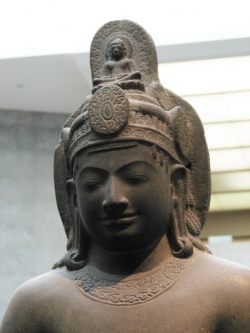Satipatthana
In the Buddhist tradition, satipaṭṭhāna (Pāli; Skt. smṛtyupasthāna) refers to foundations for (paṭṭhāna; pasthāna) or the presence of (Pali upaṭṭhāna; Skt. upasthāna) "mindfulness" (Pali sati; Skt. smṛti). The Buddha is recorded as having said that this framework for establishing mindfulness is the "direct" or "one-way path" (Pali ekāyano maggo) to the realisation of nirvana.
The "four foundations of mindfulness" (Pali cattāro satipaṭṭhānā) are canonically described bases for maintaining moment-by-moment mindfulness and for developing mindfulness through meditation. The four foundations of mindfulness are:
mindfulness of the body (Pali: kāya-sati, kāyagatā-sati; Skt. kāya-smṛti)
mindfulness of feelings (or sensations) (Pali vedanā-sati; Skt. vedanā-smṛti)
mindfulness of mind (or consciousness) (Pali citta-sati; Skt. citta-smṛti)
mindfulness of mental phenomena (or mental objects) (Pali dhammā-sati; Skt. dharma-smṛti)
In contemporary times, this practice is most associated with Theravada Buddhism as well as less secular vipassana meditation.
Translation
Satipaṭṭhāna is a compound term that has been parsed (and thus translated) in two ways:
Sati-paṭṭhāna which has been translated as "foundation of mindfulness," underscoring the object used to gain mindfulness.
Sati-upaṭṭhāna which has been translated as "presence of mindfulness" or "establishment of mindfulness" or "arousing of mindfulness," underscoring the mental qualities co-existent with or antecedent to mindfulness.
While the former parsing and translation is more traditional, the latter has been given etymological and contextual authority by contemporary Buddhist scholars such as Bhikkhu Analayo and Bhikkhu Bodhi.
Contexts
Satipaṭṭhāna is a way of implementing the right mindfulness (sammā-sati) and, less directly, the right concentration (sammā-samādhi) parts of the Noble Eightfold Path. Satipaṭṭhāna meditation develops the mental factors of vipassana (insight) and samatha (calm). Satipaṭṭhāna is practiced most often in the context of Theravada Buddhism although the principles are also practiced in many traditions of Buddhism which emphasize meditation such as the Sōtō Zen tradition.
The four satipaṭṭhāna are one of the seven sets of bodhipakkhiyādhammā (Pali for "states conducive to enlightenment") identified in many schools of Buddhism as a means for achieving Enlightenment or Awakening (bodhi).
Traditional scriptures
In the Pali Canon, this framework for systematically cultivating mindful awareness can be found in the Mahasatipatthana Sutta ("Greater Discourse on the Foundation of Mindfulness," DN 22); the Satipaṭṭhāna Sutta ("Discourse on the Foundations of Mindfulness," MN 10), and throughout the Satipaṭṭhāna-samyutta (SN, Chapter 47). The Satipaṭṭhāna-samyutta itself contains 104 of the Buddha's discourses on the satipaṭṭhānas including two popular discourses delivered to the townspeople of Sedaka, "the Acrobat" (Thanissaro, 1997a) and "the Beauty Queen" (Thanissaro, 1997b).
Key discourses among these identify the value of this practice in this manner:
Bhikkhus, this is the one-way path for the purification of beings,
for the overcoming of sorrow and lamentation,
for the passing away of pain and displeasure,
for the achievement of the method,
for the realization of Nibbāna,
that is, the four establishments of mindfulness.
Repeatedly in these discourses one finds the establishing of mindfulness explicated by the refrain:
[One] remains focused on the body ... feeling ... mind ... mental qualities in & of themselves — ardent, alert, & mindful — putting aside greed & distress with reference to the world.
The aforementioned wholesome establishments of mindfulness are contrasted with the mind-ensnaring qualities of:
The five strands of sensuality. Which five? Forms cognizable by the eye — agreeable, pleasing, charming, endearing, fostering desire, enticing. Sounds cognizable by the ear.... Aromas cognizable by the nose.... Flavors cognizable by the tongue.... Tactile sensations cognizable by the body — agreeable, pleasing, charming, endearing, fostering desire, enticing.
Contemporary exegesis
Satipatthana vs. Jhana
Bhikkhu Bodhi writes:
... Though there is neither canonical nor commentarial basis for this view, it might be maintained that satipatthana is called ekayaa magga, the direct path, to distinguish it from the approach to meditative attainment that proceeds through the jhanas or brahmaviharas. While the latter can lead to Nibbana, they do not do so necessarily but can lead to sidetracks, whereas satipatthana leads invariably to the final goal.



